13 May 2019
We have a new question! Thank you to our visitor who googled ‘when to spay a Tibetan Terrier’. ;>) See the last question.
- Where is Kensington Kennel located?
- How many litters do you have each year?
- How much do you charge for a puppy?
- Is a Tibetan Terrier right for me?
- Should I buy a Tibetan Terrier for my child?
- How much care does a Tibetan Terrier require?
- What about training for agility?
- Do Tibetan Terriers get along with other animals?
- Are there gender differences?
- How come I see so many different colors in their coats?
- What kind of home life do you suggest?
- What about outdoors?
- How do I housetrain my new puppy?
- Can I teach a Tibetan Terrier tricks?
- Is there an advantage to bringing two puppies home at the same time?
- How do you travel with a Tibetan Terrier?
- What about food and feeding?
- When is the best time to spay or neuter a Tibetan Terrier?
Where is Kensington Kennel located?


Kensington Kennel is located in Stowe, Vermont, right in the historic part of the village on Route 100. Our property abuts Sunset Hill and the woods begin behind our driveway. We welcome visits from potential forever families by appointment and have a guest house, for those who are coming from so far away that they need to stay overnight.
How many litters do you have each year?

Sometimes, we keep the pick bitch or dog puppy, if we get a puppy who looks to be better than anything we’ve bred to date out of their mother. However, we are very careful not to increase the size of our home pack, without retiring an older animal. It is mandatory to us that we have the time and focus to train and encourage each of our Tibetan Terrier puppies to blossom. That includes consistency of routine and an opportunity to watch the family’s goings-on, from a safe place. Depending upon the animal’s physical and emotional maturity – and the condition of the coat – that ‘pick’ puppy goes on the show circuit to compete in Conformation under highly accomplished and skilled handlers in one of several classes, according to age. Pamela and Mark Desrosiers handled our TTs from 2007 until 2017. Now, Rebecca Bradley is handling our animals. Back in 1992, Wendell Sammet handled our first dog.
How much do you charge for a puppy?

Is a Tibetan Terrier right for me?

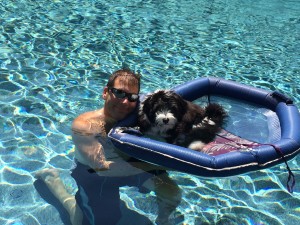
This is a good question. We find that the medium size of a Tibetan is a great size with which to live and travel. Tibetan Terriers also bring high quality intelligence and personality to the table. We’re not talking about a big dog personality, like a Berner or a German Shepherd or even a Golden Retriever. These big breeds won’t test you the way a Tibetan Terrier will, because the temperament is different. Tibetans are independent and precocious. They’re very much like six year old children – and while they can be distracted into obedience, they also have some of their own ideas. They tend to be affectionate and sensitive – you’ll find that they can intuit when you might need comfort or when you’re angry. I’ve found that a Tibetan Terrier will act as though he ‘feels badly’, even before you scold him. And I’ve found that silence and turning your back work much better than yelling at the dog. I would also encourage you to clap your hands or whistle, to try to ‘manage by sound’, instead of managing by voice. And you can also train with hand signals. I point to the ground, when I want an animal to ‘sit’. If you train them correctly, this works very well outdoors and can be INVALUABLE on sidewalks. Teaching the ‘come’ command can be challenging. Food driven TTs are the exception and not the norm – so, if you’re looking to do agility or obedience with your new companion? I would study the puppies, looking for the most food driven animal(s) for you.

So, you ask whether a Tibetan Terrier is right for you? If you or someone in your house has an anger issue – pick a different breed. Lots of loud noise or screaming in your household? Pick a different breed. Lots of kids in the household? It depends upon the children. Young children who wave their hands around in the air and run through the house? Not ideal, for a Tibetan puppy (or any puppy, for that matter). But one of the best things about Tibetan Terriers is that they will remove themselves from the chaos and noise of lots of activity and go find a table, under which to lie. Or they’ll find a couch or chair, on which to jump to escape, or go upstairs or outside. But do you really want to expose a sensitive animal to regular chaos, knowing that it will be YOUR responsibility to raise a well mannered dog and that behavioural problems stem from environmental and training issues? Maybe think about a different breed, like a Lab or a Golden. ;>)

Another thing to consider is the potential longevity of the breed. Our first Kensington Tibetan Terriers lived to be sixteen. Max and Mia were littermates from Nina Wagner’s Shalimar Kennel. Max was a very good boy and especially gentle. He was a love machine and wonderful with kids. He never lost his athleticism and was fit until the end. Mia was an acrobat and could jump four feet into the air from a standing position. She should have been in the circus! Mia was our first extremely nimble Tibetan Terrier. Then came CH Georgie Girl, GRCHB Billie Jean and now? We have GRCH Kensington’s Pic, Pic, Piccolo! Older doggies are slower and sometimes can’t hold it as long as they used to be able to – so, the challenges change, as the animals mature. Elderly dogs make wonderful companions for older people, as they move more slowly and like to sleep in your lap or lie curled up next to you or stand guard perched on a chair, looking out the window. How old will you be in fifteen years? And your children? Think about it. Remember, a puppy grows up into a young dog. And then, into an adult dog. Those are the greatest years – between two years old when the puppy matures – until ten, when they begin to enjoy shorter hikes, instead of fifteen mile traverses! But if you exercise regularly and feed your dog well — and you live in a smoke-free home with NO exposure to fertilizers or pesticides — your Tibetan Terrier may well live to fifteen or sixteen years old, as ours have done. If you haven’t had the opportunity to get to know a Tibetan, my suggestion to you is to come for a visit. Visit every breeder you are considering, to see how they live and how the animals are raised. We have Tibetan Terriers of several ages and this is one of the reasons we always have older animals in residence to help raise a pup. They make my life easier!

Some families or couples are better with an animal who is a little older and has a little more training. Housebreaking a puppy might be too much for them. Or perhaps, they don’t want to go through the higher energy level of a puppy. We have Tibetan Terriers of a variety of ages, should you decide that you might like to consider an older puppy or young dog. We might have one now or it might be in a year or two. More and more small families are seeking older animals, for a variety of reasons. We charge the same, regardless of age of the animal. Cost of spaying and neutering will be your responsibility – but we are willing to have it done by our vet and manage the post-surgical care, if that is too much for you, too. Regardless of what anyone might say, when you see Tibetan Terriers playing among themselves and you have a chance to interact with them 3D, it will help you better understand whether this breed is right for you.
Should I buy a Tibetan Terrier as a companion for my child?
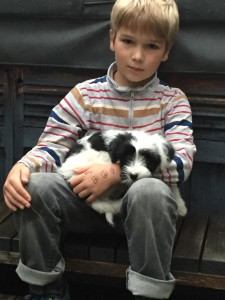
Please read the answer to question four. If you think that your child can manage a six year old, then, perhaps your child is old enough for a Tibetan Terrier. Pictured at the right is Levi, an unusually intuitive, responsible and intelligent seven year old. In 2015, he and his younger sister Claire visited and we deemed him almost ready to get a puppy of his own, as his family was still grieving the loss of their much loved Lab. After six months of discussion and visits, we were all in agreement that Levi was capable of participating in the training and care of a new dog for the family. In January 2018, Levi and his family agreed that the ideal Kensington Tibetan for their family would have been Ziva, one of our current brood bitches. However, since then? Levi has become an athletic superstar and spends all of his free time in soccer or downhill mode. So, I get to have Ziva here with me and we enjoy our days together very much. The decision about whether a TT puppy or adult is the best match for your family will be impacted by different criteria in different years.
I would never suggest that you buy a young child a puppy of his or her own – everyone must be involved and an older dog for the family could be perfect and might be better. It depends upon the situation and the level of experience living with dogs. If you’re talking about a child who has newly moved into an area and needs a friend who will be shared by the whole family – it might be a great idea. Every idea deserves discussion and I’d be happy to speak with you about your personal situation. This is also one of the reasons that I require at least one 3D visit to meet the pack, so that we can watch animal behaviours together and discuss breed suitability. A Tibetan Terrier may or may NOT be the breed that’s right for your family. I do not want to take that risk, nor should you. We are protective of this breed, as they have earned the nickname ‘Little People’ and for good reason. They can be challenging as adolescent puppies and require proper training, exercise and positive feedback.
How much care does a Tibetan Terrier require?
 Every dog requires and deserves love, training, regular veterinary care and grooming. People look at the profuse coat of a Tibetan Terrier and get scared. Remember, there are always options! And no matter what, you will always want to give your dog a regular bath, regardless of length of coat or breed — at least six times a year. You may choose to keep your Tibetan Terrier clipped very short, as I did with my first two. Or you may choose to keep the coat only a couple of inches long, in a ‘puppy cut’. Either option is perfectly fine and your dog might very much like his coat kept short and clean, especially in summer – it might lead to more petting and easier baths. Some of the families who have brought Kensington Tibetan Terriers into their homes enjoy maintaining the full length coat. If you visit us, you will see how we groom our Tibetan Terriers. We brush and comb them daily and bathe them every couple of weeks in winter. We find it enjoyable spending five or ten daily minutes with a comb on each dog, going through their beautiful long hair. And they seem to enjoy it, too. They know that they’re beautiful and they love the attention.
Every dog requires and deserves love, training, regular veterinary care and grooming. People look at the profuse coat of a Tibetan Terrier and get scared. Remember, there are always options! And no matter what, you will always want to give your dog a regular bath, regardless of length of coat or breed — at least six times a year. You may choose to keep your Tibetan Terrier clipped very short, as I did with my first two. Or you may choose to keep the coat only a couple of inches long, in a ‘puppy cut’. Either option is perfectly fine and your dog might very much like his coat kept short and clean, especially in summer – it might lead to more petting and easier baths. Some of the families who have brought Kensington Tibetan Terriers into their homes enjoy maintaining the full length coat. If you visit us, you will see how we groom our Tibetan Terriers. We brush and comb them daily and bathe them every couple of weeks in winter. We find it enjoyable spending five or ten daily minutes with a comb on each dog, going through their beautiful long hair. And they seem to enjoy it, too. They know that they’re beautiful and they love the attention.What about training for agility?
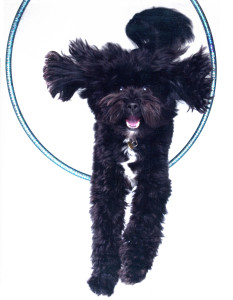
There is a puppy from Izzie’s first litter named Beau. Beau was a natural for agility and his humans have had great fun working with him. All dogs can learn to do agility – they just do it more or less well! Once again, all it takes is consistency, patience and regular training. But since we spend most of our time raising young pups and training older ones, we haven’t had a chance to try our hands at agility with any of our own dogs. So, to see the real answer to your question, go to youtube.com and search for Tibetan Terriers doing agility. There are a couple of highly skilled adult Tibetan Terriers who will knock your socks off, when you see what they can do. They can dance and sing, too.
Clicker training is something we are just learning and Beckham, our young male from Markus Gisslen in Sweden, loves it! Maureen Dwyer has introduced us to ‘manding’, another technique whereby you teach your animal to demonstrate a behavior, when he or she wants to communicate something with you.
Do Tibetan Terriers get along with other animals?

Intact animals will often behave differently than neutered animals. We sell with a spay/neuter contract. This means that you are required to have your puppy spayed or neutered, once it has reached sexual maturity. It is very important to understand a dog’s natural instinct to protect and defend his pack. Alpha dogs will always be more alert to strangers and more wary of them. They have a job to do. Fortunately, there are very few alpha dogs in the Tibetan breed. However, it should always be emphasized that you want to introduce adult animals to one another with respect and in carefully controlled environments. Some dogs are different on-leash, rather than off-leash. It’s important to understand your animal’s personality. Puppies who are raised with other animals will treat any new animal like a friend. We’ve raised Tibetan Terriers with cats, horses, Bernese Mountain Dogs, chickens, ducks and cockatiels. How you work to socialize an animal will be reflected in that animal’s future behavior. And once you eliminate the testosterone from a boy doggie at neutering, those behaviors are pretty much guaranteed to be what you get long term, unless there are other factors at play. Aggressive children or animals are not something you want around a new puppy. New puppies are happy and playful and still a little fragile. They’ve never had a bad experience and it is not fair to jeopardize an animal’s welfare with aggressive behavior from another creature. This is absolutely NOT something you want to ignore! Just as people contribute to the development of scary pit bulls, you can contribute to the development of a frightened, angry Tibetan that will not be a good reflection of the breed. We have seen some very sorry animals come out of Tibetan Terrier puppy mills and some of these animals never recover. The key to raising a friendly and respectful animal who gets along well with other animals is proper socializing and healthy play, beginning at a very young age.
Are there gender differences?
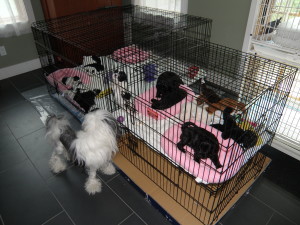
It has been our experience that females tend to be a little more independent and males tend to be playful love machines. But it must also be noted that in nature, females are the ones genetically programmed to whelp, feed, raise & protect the puppies. Males, on the other hand, have only one thing genetically programmed into them and that is to make puppies, when the opportunity presents itself. At all other times, their only responsibility is to play! So, boy puppies can be challenging, when all they want to do is play! Dig deep and find your sense of humor. Boy doggies are cuddle muffins and want nothing more than to curl up, make eye contact and have bodily contact with you, once they’re tired! Females are queens and enjoy being adored. Kensington females are healthy and spirited. Obedience & good manners are things that are trained into an animal, regardless of gender – so, remember, that’s your responsibility. Obedience is not automatic! And we start very young to teach manners. Play is ALWAYS supervised and we keep our larger litters divided up into three animals per playpen.
How come I see so many different colors in their coats?

There is no color standard in the Tibetan Terrier breed. And there are something like sixteen genes involved in the genetics of canine coat color. So, while white is the absence of pigment and is dominant, the double coat of a Tibetan often comes with at least two colors – and those might be black and some white. Once an animal has white in its coat, it will never produce a puppy without white – even just a little bit! To make things even more interesting, Tibetan Terriers change their coat colors, as they mature. You’ll find at two or so years of age, your black dog might go charcoal. Or your red brindle dog might go blonde. Here at Kensington, we have had a red brindle who has gone whiskey with black tipping – a red brindle who has gone blonde with black tipping – two black and whites who have gone charcoal and white – a white and black who has gone white and charcoal — and a black and white who changed to charcoal and white at two – and then, back to very black and white, at four! You should never base the selection of a puppy on coat color alone. Instead, you should ALWAYS base a puppy selection on temperament and health – but having a coat color preference is certainly understood. In fact, I have one forever family who has been waiting through three litters for the coat color they want.
What kind of home life do you suggest?
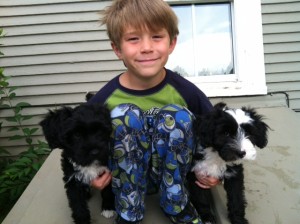
Tibetan Terriers can take a fair amount of variety in their home lives, as long as they know they’re welcome, who’s the boss and where they’re supposed to sleep. This is one of the reasons we recommend crate training. It very much aids in happy travel experiences and also, in a predictable home life. What kind of a home life do I suggest? A happy one, without a whole lot of unnecessary loud noise. Someone to play with, whether with two legs or four. A variety of dog toys to chew on and to carry – enough money and time to provide proper veterinary care, good quality dog kibble and attention to fresh water. At least one dog bed or crate – a blanket to throw on the couch, if you choose to allow your dog to share the couch with you. Tibetan Terriers love their humans, especially the one(s) that play with them! So, share the feeding & exercise duties with your kids or your spouse and everyone can share in the love. A fenced yard is very important, for peace of mind and for ease of housetraining. If you don’t have one, you’ll need to leash walk your dog at least four or five times a day while they’re young. As they grow, their little bladders will grow, too, and they’ll be better able to ‘hold it’ during the day. When they’re left alone in their crates and their humans leave, they’ll expect and need to be let out immediately after you return – that is, after they’ve showered you with love and licks. If you wait to take them out, they might have an accident. It’s all part of the excitement of your walking in the door – so, please be kind and remember to take your doggie out first thing, after returning home. You are responsible for your dog’s success.
What about outdoors?

Most dogs love their time outdoors and all require shade, when it’s hot outside. Tibetan Terriers prefer cold to hot – and you will find your doggie sprawled out with maximum belly contact on a tile floor in the heat of the summer. It is best to have a fenced in area for your dog, so that you can have a break and they can dig the occasional hole or roll on the ground. Doggies will be doggies! It’s also good maintenance to pick up after your dog and dispose of the poops. Raking the fenced area at least twice each year is a good habit, too, especially in early spring and after the leaves fall. Everything will be much easier, if you clean up weekly. Tibetans are allergic to flea bites and if you get a flea – you’ll find your doggie scratching way beyond what’s ‘normal’ – and maybe even to the point of scratching themselves raw. This will be your fault. ALWAYS USE FLEA & TICK PROTECTION. Use it consistently and monitor the timing between baths and application of the topicals. The stuff works if you use it properly and it WILL keep the fleas away. It is NOT a systemic and stays on the skin, spread around the body by the oils on the skin. Alternatively, there are ingestibles that are marketed as ‘safe’ for dogs. Talk to your vet about the ingestible options, too. Allowing your dog to be bitten by a flea or tick has terrible consequences. Don’t tempt fate. Use flea protection. And always provide fresh water for your doggie, whether he or she is outside or inside. Don’t put food outside, as it will attract flies, ants and other critters. And be sure to keep an eye on your doggie, even when confined by a fence. Outside should not mean ‘out of mind’.

Another thing to address and emphasize is TICK PROTECTION. Ticks spread Lyme Disease and it is terrible thing to witness. The fever comes on fast and is very high. The lameness and lethargy come on even faster. You will watch your animal deteriorate, right in front of your eyes and not know what’s wrong. Research indicates that long term effects from Lyme can include compromised immune systems AND kidney failure.
I believe in having your yard sprayed with TickKilz, as it is totally natural and like garden plant insecticides, it is a soap based spray with essential oils to deter/kill ticks and mosquitoes. It works. I used it in Princeton, Massachusetts and was amazed at how successful it was at eradicating the ticks from around my house. I use it religiously, here in Vermont. Please talk with your local pest control service, if you live in a State known for its deer tick population.
How do I housetrain my new puppy?
Can I teach a Tibetan Terrier tricks?
Come! Now, that’s a special command and one where you will have to be consistent and use lots of rewards. I don’t always use food rewards. I use verbal praise and petting just as often, because I don’t want the dog to think that he’s going to get a treat EVERY time he obeys. Pick up a dog training book, if you’d like to do a really good job training your dog. You can read about ‘clicker’ training, agility and some animal behavior theory, all of which will give you good ideas to think about.
Is there an advantage to bringing two puppies home at the same time?
But there is a flip side to it and the possibility that the two puppies will bond more to one another than to you. In order to fully eliminate that possibility, some of my forever families choose to bring puppies home from successive litters. That way, each puppy gets to be a puppy! and then, when the second puppy comes home? There is an older animal to help teach them the ropes. Everything comes easier and faster for the second puppy, often because they learn by watching the older animal’s behaviour with you.
But there is twice the expense and that includes food and veterinary care. Think carefully about this.
Crate training pairs allows them to entertain each other. They seem to thoroughly enjoy having a companion in their crate and will kennel together, when given the choice of multiple kennels. Many of my clients have come to me to find a second Tibetan Terrier for a Tibetan Terrier they’ve already owned for a while. A younger pup rejuvenates an older dog and the older one tends to train the younger one to follow in his or her footsteps. Regardless of gender, the older Tibetan Terrier usually lets the younger Tibetan Terrier ‘rule the roost’. But that older dog also keeps the younger one in line. Some people have come back to me to purchase a second Kensington Tibetan Terrier, one year after having purchased their first. In all of these instances, we have people who have the space & time – and who want the best for their Tibetan Terrier. They often see that a companion will be the best gift they can give their favored pet and two is at least double the fun – and not as much as double the work.
How do you travel with a Tibetan Terrier?

Traveling with one Tibetan is a breeze. Depending upon your vehicle and the size & age of the animal, you might want to consider different options. Puppies should always be crated for car travel. If you use a wire crate, you may orient it however best fits your car. If you use a plastic crate, orient it so that the door or side with maximum ventilation faces open space. Do not snug the side with maximum ventilation up against the tailgate or inside panel of a vehicle. You NEVER want to cut down on ventilation, even in winter. Young dogs should also be crated for car travel. Same guidelines apply regarding ventilation.Adult dogs can be trained to sit in a car bed that is belted into position. The back seat is safest, same as for young children. But traveling with crated dogs protects them from accidents and airbags better than if they roam freely within the vehicle. I don’t advise letting your animal roam freely in the car.You should ALWAYS travel with water for your animal (and for yourself!). And you should always travel with at least one extra leash and collar in your glovebox. Dogs will usually fall asleep in their crates and adult dogs should be fine for three or so hours. But for longer trips, it’s healthy and respectful to get out and stretch everyone’s legs – whether furry or not!
What about food and feeding?

Kensington Tibetan Terriers are started out on Royal Canin puppy kibble. It has been my experience that this brand of kibble yields smaller poops and that means more complete digestion. We also treat with dried organic beef liver, dried sweet potato chips, carrots, salmon skin & flesh, any veggie cooked in chicken stock and Stella & Chewy’s freeze dried patties and meal mixers. The salmon provides nutrients & fat for healthy skin & glossy coats – and calcium for good bone development. NEVER to feed cow’s milk or cream to a dog. They can’t digest the lactose – but cheddar cheese and yogurt is aok, as the lactose is broken down during fermentation. As young adults, I switch and feed Taste of the Wild Smoked Salmon or Purina Sensitive Skin and Stomach dry kibble. In winter, I drizzle a little fish oil on top and sometimes, dehydrated liver crumbs from their dehydrated liver treats. There are foods we should never feed our dogs including grapes, raisins, onions and chocolate. But sweet potatoes & yams, cooked meat, cooked beef bones and rice are certainly fine in small amounts. A diet rich in human food leads to the runs – and that is no fun for anyone! If you’re going to treat with human food, do it sparingly and NOT AT THE TABLE!
When is the best time to spay or neuter a Tibetan Terrier puppy?
Gosh, you’re going to get different answers to this question, depending upon with whom you discuss this topic.
I require that you allow your female TT puppy to experience AT LEAST ONE SEASON, before you consider spaying her for two reasons: The first is that you want her internal and external female parts to be fully developed, before you remove them. There is research that has shown a correlation between early spaying and premature incontinence in adult female TTs. The second reason is that I believe that the hormones produced are probably more valuable than we might think, up until the puppy reaches full physical maturity (~24 months), as the hormones are valuable to the development of joints and skeleton in the male and I see no reason why it would be different for the development of the female.
I strongly suggest and I know that I have no control, once the animal is released by me, that you wait until your male puppy is at least 24 months old, before you have him neutered. The ONLY reason for this is that research shows that testosterone is necessary and valuable for the complete development of joints and skeleton in male canines. There are many, many bones and growth plates involved in a healthy canine body. Please read this article for really GREAT information on all of the potential injuries that can happen in a developing puppy’s first two years. As I come upon other articles? I will post the links here, too.